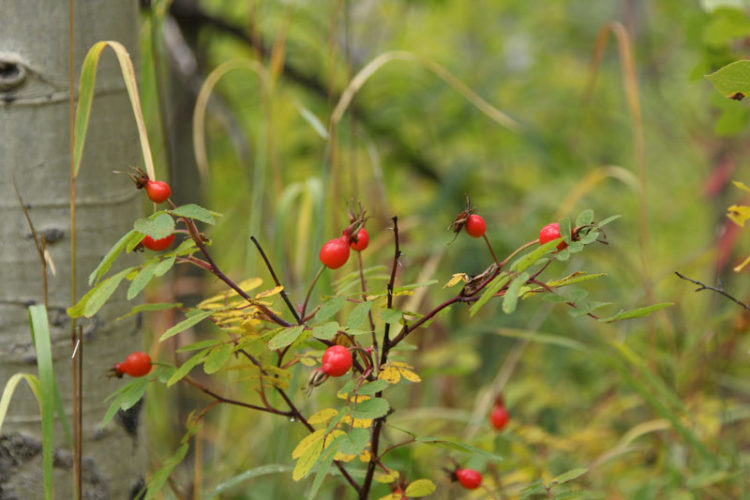
Legions of soft, plump, frost-kissed rosehips hang heavy upon their slender, prickly stems. Many are perfectly ripe, slipping off the ends of their branches with a soft, orange gush, leaving a sticky paste to be licked off the fingers.
First I made rosehip sauce by cooking the hips down in enough water to cover and then mashing the softened fruits through a screen to save the liquid paste while discarding their itch-causing seed hairs. I sugared the filtered stuff gently and cooked it down to thicken.
But the rosehips continued to call to me after that, so we headed out under overcast skies for a second batch, visions of whole dried rosehips for wintertime teas dancing in my head. Plus I wanted to de-seed a small batch to dry for use as rosehip “raisins” in granola, and to cook down another fresh batch into my first attempt at rosehip soup, a popular dessert in Scandinavia and Iceland.
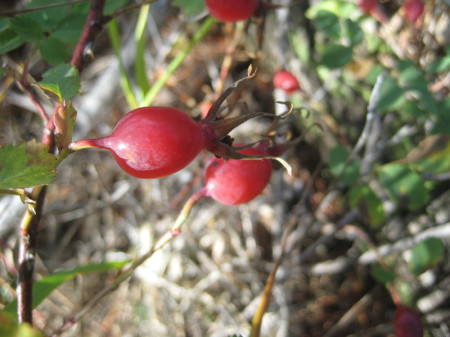
We had the forest to ourselves that day due to the inclement weather. Gregg busied himself putting his camera away every time the skies opened to release short bursts of light drizzle, and then pulling it out again when the rain let up. But the views were gorgeous nonetheless, the floor of the aspen grove dappled with the yellow leaves of the season’s change, while more fluttered in the breeze—green, yellow, and red in contrast with the backdrop of so many tightly-packed, tall, white trunks.
The rose bushes were interspersed, a few still green but most turning yellow and gold, making the bright red hips all the more evident upon them. Some hips were tiny, others nearly an inch in length. Some bushes were tall; other came up only to my calf. These traits varied as we walked, as the aspect of the hill and growing conditions changed from dry slope to wet gulch, shade to sunny exposure.
I aimed mostly for soft hips, plucking them from branches and depositing them into my bag as we walked, leaving more hips upon the branches than those I picked, and spreading out the harvest so as not to denude an area. In total, I got maybe a gallon—enough to dry a couple pints and still have some left over to play with in the kitchen.
By the end of the hike, a light snow was falling. This truly is a magical place.
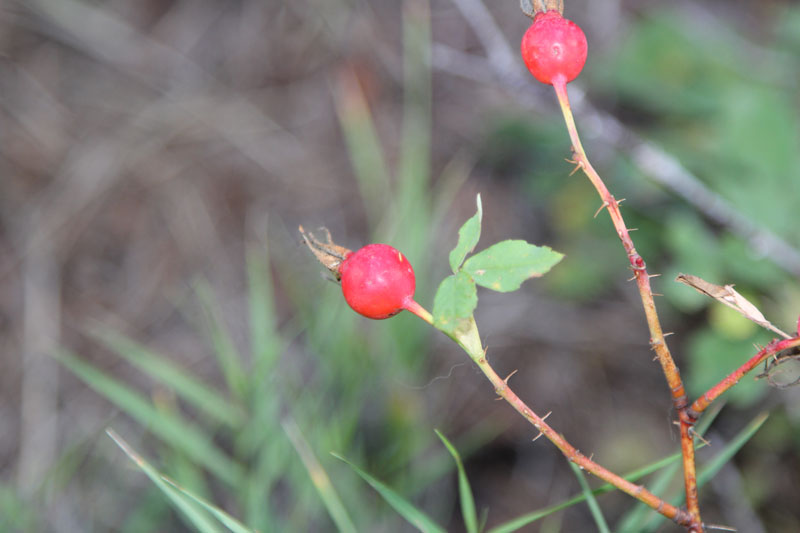
A Rose is a Rose; A Hip a Hip
Rosehips are the hips, or swollen bases, of rose flowers in Rosa species, both domesticated and wild. As long as you have a true rose, it’s okay to eat. Garden roses can be substituted for wild roses, as long as they have not been sprayed.
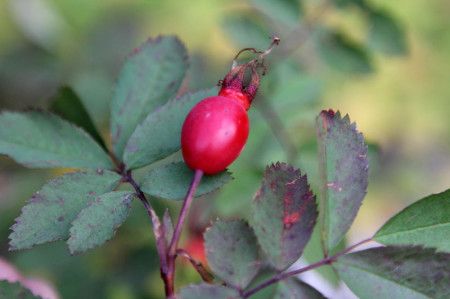
Photo by Gregg Davis.
Most parts of roses are edible—including buds, young leaves, shoots, and hips. However, the hips should not be eaten whole due to sliver-like hairs attached to the dry inner “seeds” or achenes that can irritate the digestive tract and cause “itchy bum.” In addition, all members of the Rose family have cyanide-like compounds in their seeds, which are destroyed by cooking or drying.
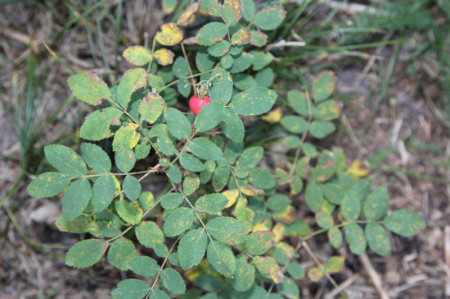
The family Rosaceae is quite large, including such well-known genera as apples (Malus), strawberries (Fragaria), raspberries (Rubus), cherries and plums (Prunus), serviceberries (Amelanchier), and hawthorn (Crataegus), to name only a few. There are approximately 100 genera within Rosaceae worldwide (around 50 in North America) containing 3,000 species, per Thomas J. Elpel (Botany in a Day, 2013 ed.). They are often characterized by flowers that have five sepals and five petals with numerous stamens, along with oval, serrated leaves.
Both wild and cultivated roses belong to the genus Rosa, which are thorny or prickly shrubs with deciduous leaves pinnately divided into 5-7 toothled leaflets. Since the leaflets are odd-numbered, there should be one terminal leaflet that does not have an opposite partner.
Rose leaves are dark green and smooth, writes Virginia-based forager Katie Letcher Lyle (2010), with hips or haws that vary greatly in size and color. “The darker the rose, the more potent the hip, goes one old saw,” she writes.
“Some hips are plump and juicy while others may be sparse and mealy,” write Alan and Sue McPherson (1979), early Denver edible wild plant writers. “The only way to find a good stand is to search and taste.” To field-taste rosehips without swallowing seeds and hairs, I like to gnaw off the outside like miniature, pink ears of corn.
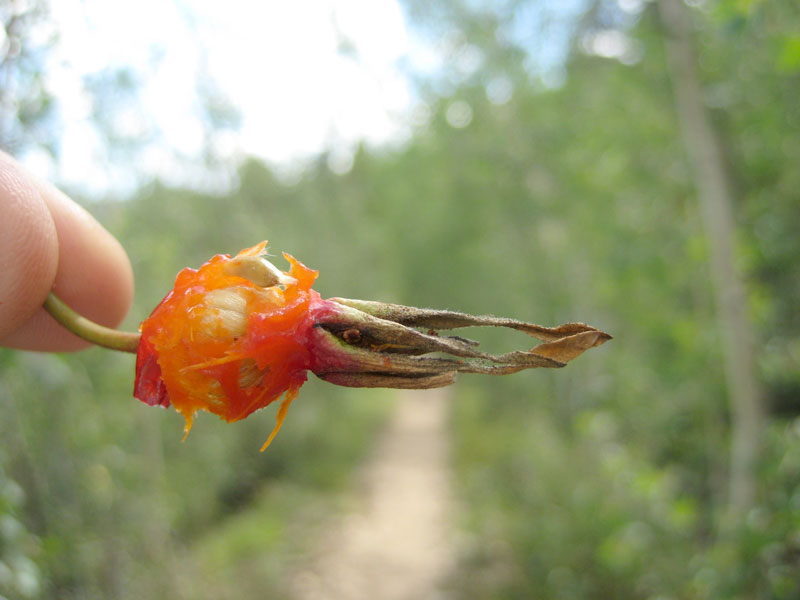
Vitamin C & So Much More
Rosehips are renowned for their high vitamin C content. “Fresh, ripe rose hips are the most potent source of vitamin C in the Rockies,” Cattail Bob Seebeck (2012) writes. “One rose hip is equal to about 500 mg of vitamin C.”
Rosehips were an invaluable source of vitamin C for people in northern Europe and Great Britain during World War II, Lyle explains, when oranges and other citrus fruits were unavailable.
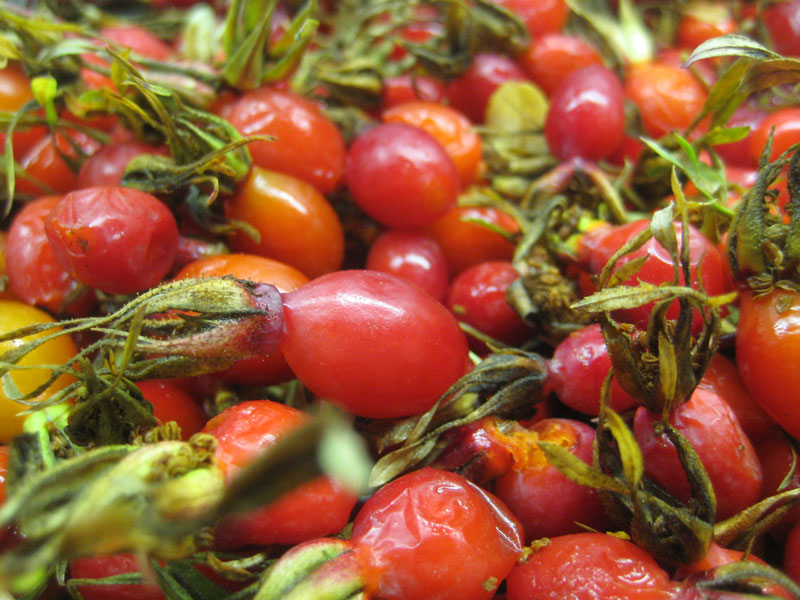
Sunny Savage gives a good overview of the various other nutrients in rosehips—among them beta-carotene, calcium, iron, phosphorous, pectin, and phytochemicals like lycopene, bioflavonoids, and polyphenols. She also notes that beads made from rose petals were the original rosary beads.
Today, herbalist Henriette Kress prescribes taking out some rose beads when you’re “in need of some love, gentleness, courage—or a bit of prickliness.” Making them is a bit of a lengthy process that involves chopping, heating and cooling a mass of petals several times a day for 3-5 days, forming them into balls and then drying—a process she describes step-by-step in her book, Practical Herbs (2011). She indicates the use of rosehips “if you’re tired or exhausted, as a source of vitamin C, and when you must recuperate from an ordeal.”
Prepping & Processing
My earliest memory of rosehips dates back to the summers of my middle school years, when my family would vacation along a salt pond in Misquamicut, Rhode Island. I have fond memories of floating on rafts out to the clam beds with my sister, sometimes capsizing in fits of giggles into the sucking muck.
Along the shore of the pond there were fat, ripening red rosehips. Having read brief accounts of their use as food, I’d turn these over and over in my hands contemplating just how, in fact, a person might go about eating them. But I would not eat my first rosehip until several decades later.
Most wild food writers say to wait until frost renders an icy kiss upon the hips before picking; it sweetens them and turns their color from opaque to translucent.
But for herbalists, Kress (2011) recommends picking rosehips before a hard frost, making it easier to slice them for drying. For the slice-and-dry method, she says to remove the stalk and flower-side leaf rosettes, then slice the hips into four equal parts. If you’re drying them whole, on the other hand, remove the stalk but leaving the flowery bit intact to hasten drying.
You can carve the irritating seeds and hairs out of the fresh or dry hips, or make tea with whole hips and then use a coffee filter if you are concerned about hairs, although I’ve never had a problem with them in tea. Whole fruit can be cooked and mashed through a filter to separate seeds from rosehip sauce and juice.
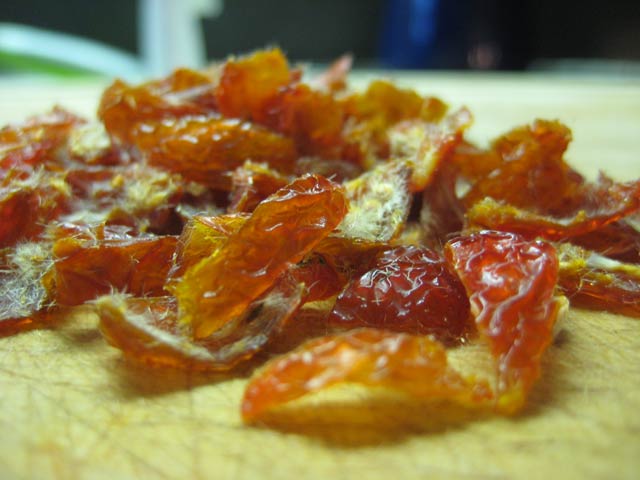
I once made “rosehip raisins” from fresh hips, separating seeds and hairs before drying by halving them and cutting the seeds out. Because the hips were so small and soft, however, this proved difficult, so I ended up squeezing out the seeds and their casings, along with a bit of edible orange goo. I set the soon-to-be raisins—the skin and whatever goo I could get along with it—out to dry. Then I took the seeds and remaining orange goo and cooked them down to extract a wee bit more rosehip sauce, which was yummy—strained of its itchy parts and mixed with honey—in both oatmeal and kefir.
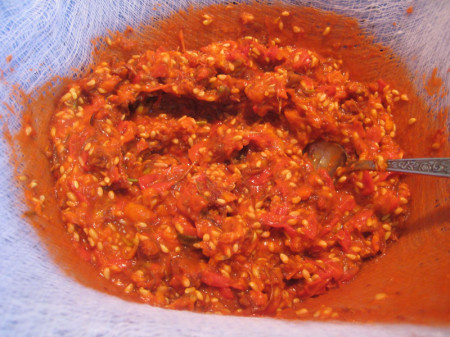
Cooking Wild
Rosehip jelly is a popular preparation dating back to medieval times. Recipes abound, though the one time I tried to make it I ended up with a gooey, sugary sauce that was more like a candy spread than a jelly. This got me thinking how much more valuable a sweet sauce is to me in the kitchen than jelly, which we don’t eat often in our household. The sauce has become somewhat of a staple in my kitchen. One of my favorite uses is ginger and rosehip vinaigrette.
After cooking rosehips down and straining out the seeds, Jennifer Hahn (Pacific Feast, 2010) recommends whisking in warm water, arrowroot, and honey, stirring until thickened, “..and abracadabra—nectar of the gods.”
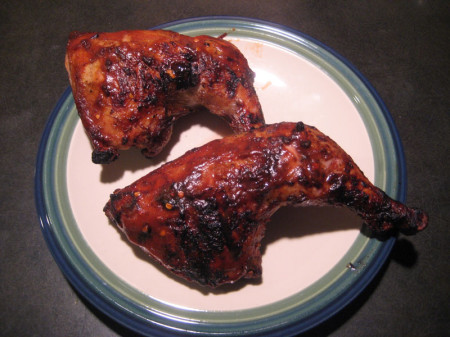
This is essentially what the various recipes for rosehip soup promise—a thickened, sweetened, strained rosehip puree that can be served with whipped cream for an unusual sweet dessert. I made my own version and served it to Gregg without the whipped cream, as we didn’t have any. He said as many nice things as he could think to say before sheepishly handing the bowl back to me, nearly full. “It’s enough to try to visualize soup as dessert,” he said, “but without the whipped cream I just don’t know. I think I’d rather have this on top of ice cream.” No matter. He’s right—that “soup” would be great on ice cream too. I later learned from my friend Sam Thayer that some rosehips have a much sweeter flavor than our local, relatively bland rose hips here in the high country.
The following night I handed the leftover soup to Gregg and asked him to make it into a barbecue sauce. He searched online for some recipes to guide him and then threw together a messy batch of rosehip barbecue sauce, which contained the rosehip soup/sauce plus ketchup, Penzey’s BBQ 3,000 spice, spicy brown (wet) mustard (in place of dry), brown sugar, red pepper flakes, garlic powder, Worcestershire sauce, red wine vinegar, salt, and pepper. He painted that onto some chicken we had going on the grill outside, and served them slightly charred. They came out zingy and awesome. Later, I used the leftover bones and chicken bits to make a rosehip barbecue chicken soup with pozole. That turned out good too.
In A Naturalist’s Guide to Cooking with Wild Plants (1975), the Krochmals recommend putting rosehip syrup over baked Alaska. They also have a recipe that uses a sauce of powdered rosehips and sour cream served with breaded and fried zucchini.
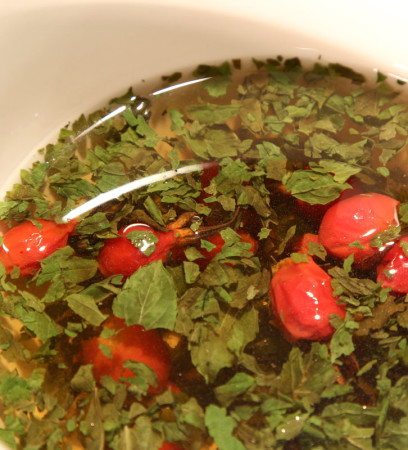
Seebeck (2012) writes that the entire dried-and-ground hip can be used, seeds and all, though I’ve also read of folks winnowing out the fine hairs after grinding—so various iterations of dried rosehip seeds are next on my list of things to try. Since the hips can often be found dangling from bushes long into winter, there’s plenty of time for that, even after the snow begins to fall in earnest.
Hahn (2010) lists chilled fruit soups, harissa, chutney, sorbet, conserves, syrup, pastry filling, tarts, applesauce, pudding, and fruit leather as other culinary uses.
But “if you want to go all out,” the McPhersons write (1979), “serve rose-hip tea” using fresh (chopped) or dried (whole) rosehips steeped to the desired strength.
Elpel, too, is a big fan of rosehip tea. “Rose hip tea is one of my all-time favorites, even better if left in the kettle overnight,” he writes.
This is in contrast to Michael Moore’s assertion (2003): “Let me be frank here: at best, rose hip tea tastes like feeble raisin and hibiscus tea.” Instead, he says, “You gather rose hips because they are up there, abundant, free, renewable, and they get you out of the house and away from the forced-air heat or woodstove smoke.” Not exactly a ringing endorsement of rosehip tea—but of being outdoors, yes.
Me, I like rosehips because they’re wild. But what else would you expect?
Updated 2.23.21


thanks for the info on rose hips
Thanks for this detailed post! We already started to gather rose hips too in Austria. We are very looking forward to making good old jam.
Cenaturimus